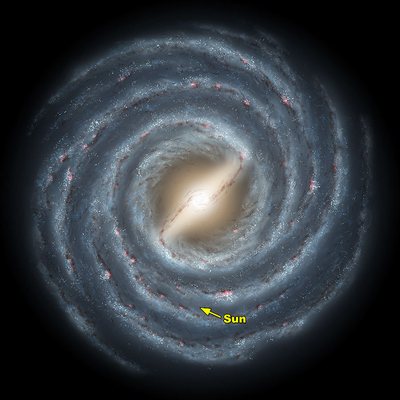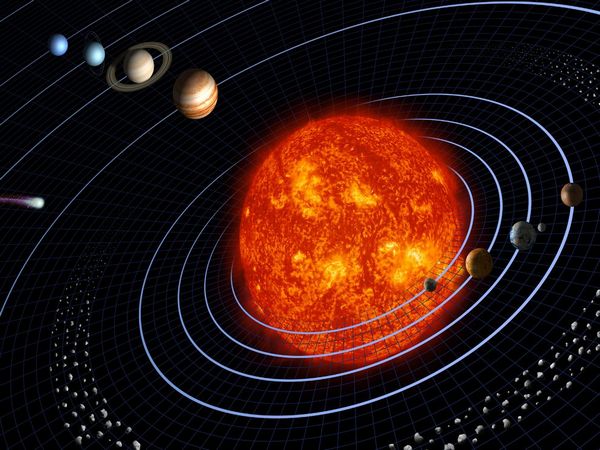The Sun – Unique Star

Content:
Our Sun is truly a unique star, only because its luminosity has allowed to create conditions suitable for life on our planet Earth, which is at an ideal distance from the Sun Since ancient times, the Sun was under the attention of a man. If in ancient time, priests, shamans, druids worshiped the Sun as a god (there were solar gods in all pagan cults), now the Sun is actively studied by scientists: astronomers, physicists, astrophysicists. What kind of star is the Sun? What are characteristics of the Sun? How old is the Sun? We’ll answer these questions in our article.
Position in the Galaxy
Despite its huge size relative to our planet (and other planets) on a galactic scale, the Sun is far from being the biggest star. The Sun is a very small star; because there are stars that are much bigger than the Sun. Therefore, astronomers attribute the Sun to the class of yellow dwarfs.
The Sun located in the Milky Way galaxy, closer to the edge of Orion’s arm. Remoteness from the center of the galaxy is 7.5-8.5 thousand parsecs. In simple terms, we are not in the center of the Galaxy, but not in its border as well.

Here is the location of the Sun on the galactic map.
Physical Characteristics
According to the astronomical classification of celestial objects, the Sun belongs to the G-class star. The Sun is brighter than 85% of other stars in the galaxy, many of which are red dwarfs. The diameter of the Sun is 696342 km, weight – 1.988 x 1030 kg. If we compare the Sun with the Earth, then it is 109 times bigger than our planet and 333000 times more massive.

The comparative size of the Sun and other planets.
Although the Sun seems yellow to us, its true color is white. The visibility of the yellow color is created by the atmosphere.
What is the temperature of the Sun? The Sun surface temperature is 5778 degrees Kelvin (9940,73 °F), but as it gets closer to the core, it increases even more – the Sun core temperature is 15.7 million degrees Kelvin (27 million degrees Fahrenheit).
Besides this, the Sun has a strong magnetism; there are north and south magnetic poles and magnetic lines on its surface, which are reconfigured at intervals of 11 years. Intense solar emissions occur during these processes. The solar magnetic field affects the Earth’s magnetic field.
Composition
Our Sun mainly consists of two elements: hydrogen (74.9%) and helium (23.8%). Besides them, there is: oxygen (1%), carbon (0.3%), neon (0.2%) and iron (0.2%). The Sun is divided into layers inside:
- core,
- radiation and convection zones,
- the photosphere,
- the atmosphere.
The core of the Sun has the highest density and occupies approximately 25% of the total solar volume.

The composition of the Sun.
In the solar core, nuclear energy is generated by nuclear fusion that transforms hydrogen into helium. In fact, the core is a solar motor of its own kind; thanks to it, our Sun emits heat and warms us all.
Sunspots
There are spots on the Sun. Sunspots are darker areas on the solar surface, and they are darker because their temperature is lower than the temperature of the surrounding photosphere of the Sun. The sunspots themselves are formed under the influence of magnetic lines and their reconfiguration.
Solar Wind
The solar wind is a continuous stream of plasma coming from the solar atmosphere and filling the entire solar system. The solar wind is formed due to the high temperature in the solar corona, the pressure of the overlying layers cannot be balanced with the pressure in the corona itself. Therefore, there is a periodic release of solar plasma into the surrounding space.
Solar Eclipse
The solar eclipse is a rare astronomical phenomenon, in which the Moon covers the Sun, completely or partially.
Schematically, a solar eclipse looks like this.

Evolution
Scientists believe that the age of the Sun is 4.57 billion years. At that time, it was created from a part of the molecular cloud represented by helium and hydrogen.
How was the Sun formed? According to one hypothesis, the helium-hydrogen molecular cloud (due to the angular momentum) started rotation and simultaneously began to heat up rapidly as the internal pressure increased. At the same time, most of the mass was concentrated in the center and turned into the Sun itself. Strong gravity and pressure led to an increase in heat and nuclear fusion, thanks to which both the Sun and other stars work.

This is the evolution of a star, including the Sun. According to this scheme, our Sun is in the phase of a small star, and the current solar age is in the middle of this phase. After 4 billion years, the Sun will turn into a red giant, further expand and destroy Mercury, Venus, and possibly our Earth. If, however, the Earth as a planet survives, then life on it will no longer be possible by that time. After 2 billion years the Sun’s glow will increase to such an extent that all terrestrial oceans simply boil away, the Earth will be burned and turned into the desert. The temperature on the Earth’s surface will be 70 °C (158 °F). Therefore, we still have about a billion years to find a new refuge for humanity in a very distant future.
But back to the Sun, becoming a red giant, it will stay in this state for about 120 million years, then the process of reducing its size and temperature will begin. When the remnants of helium in its core will be burned the Sun will lose its stability and explode, becoming a planetary nebula. The Earth at this stage (as well as the neighboring Mars) will most likely be destroyed by a solar explosion.
After another 500 million years, a white dwarf will form from the solar nebula.
Interesting Facts
- Inside the Sun, you can put a million planets like the Earth.
- The shape of the Sun forms a nearly perfect sphere.
- 8 minutes and 20 seconds – during this time the sunbeam gets to us from its source, despite the fact that the Earth is 150 million kilometers away from the Sun.
- The word “Sun” originates from the Old English word, meaning – “South”.
- We have bad news for you; the Sun will destroy the Earth in the future. However, this will happen not earlier than in 2 billion years.
References and Further Reading
- Pitjeva, E. V.; Standish, E. M. (2009). “Proposals for the masses of the three largest asteroids, the Moon-Earth mass ratio and the Astronomical Unit”. Celestial Mechanics and Dynamical Astronomy. 103 (4): 365–372. doi:10.1007/s10569-009-9203-8. ISSN 1572-9478.
- Jump up to: a b c d e f g h i j k l m n o p q r Williams, D.R. (1 July 2013). “Sun Fact Sheet”. NASA Goddard Space Flight Center. Archived from the original on 15 July 2010. Retrieved 12 August 2013.
- Zombeck, Martin V. (1990). Handbook of Space Astronomy and Astrophysics 2nd edition. Cambridge University Press.
- Asplund, M.; Grevesse, N.; Sauval, A.J. (2006). “The new solar abundances – Part I: the observations”. Communications in Asteroseismology. 147: 76–79. Bibcode:2006CoAst.147…76A. doi:10.1553/cia147s76.
- “Eclipse 99: Frequently Asked Questions”. NASA. Archived from the original on 27 May 2010. Retrieved 24 October 2010.

Author: Pavlo Chaika, Editor-in-Chief of the journal Poznavayka
When writing this article, I tried to make it as interesting and useful as possible. I would be grateful for any feedback and constructive criticism in the form of comments to the article. You can also write your wish/question/suggestion to my mail pavelchaika1983@gmail.com or to Facebook.

